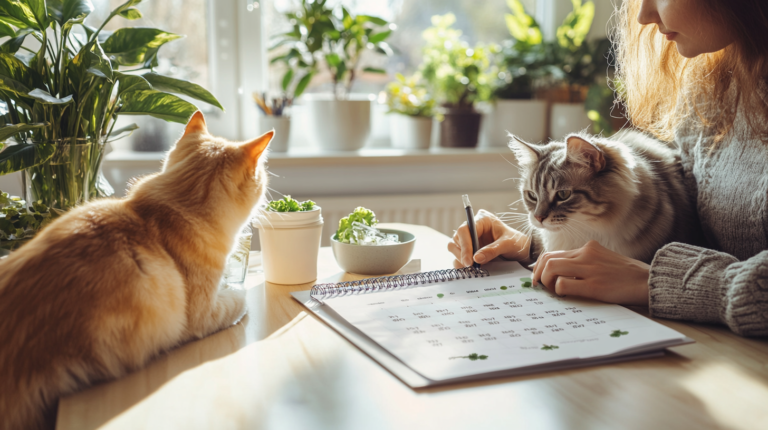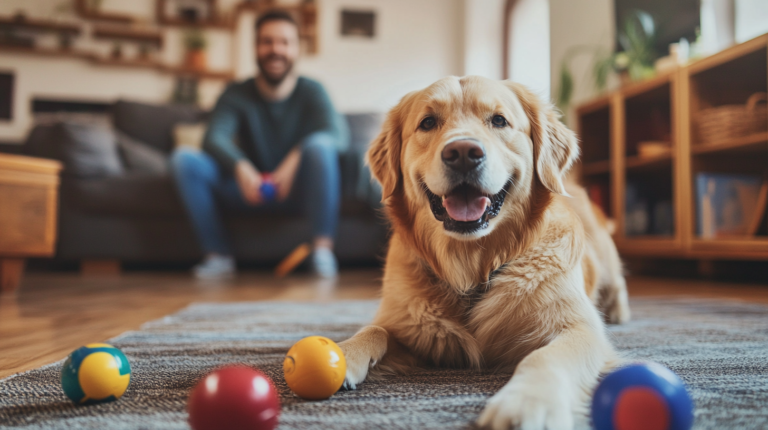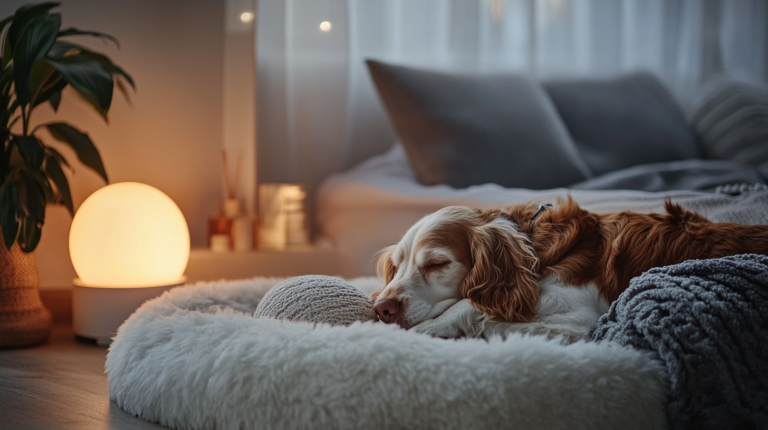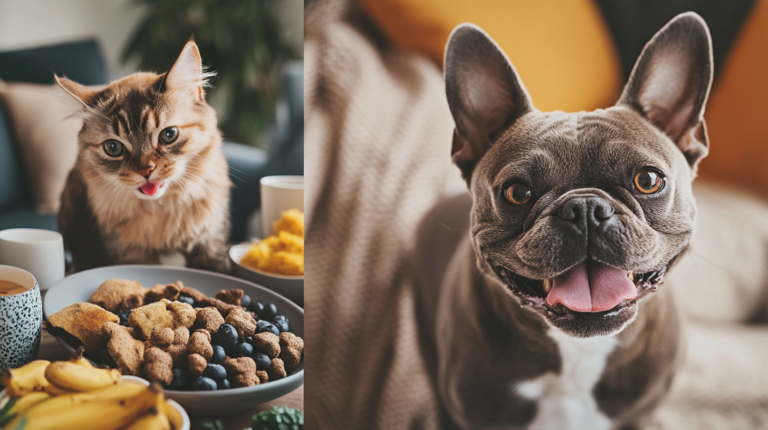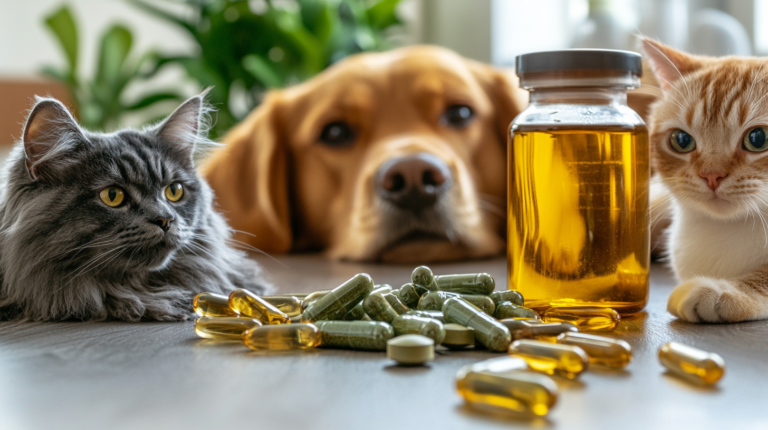Discover 5 gentle, effective techniques for calming stressed pets quickly. Our expert guide covers natural methods to help anxious dogs and cats find relief fast.
Table of Contents
Introduction: Understanding Pet Stress and Anxiety
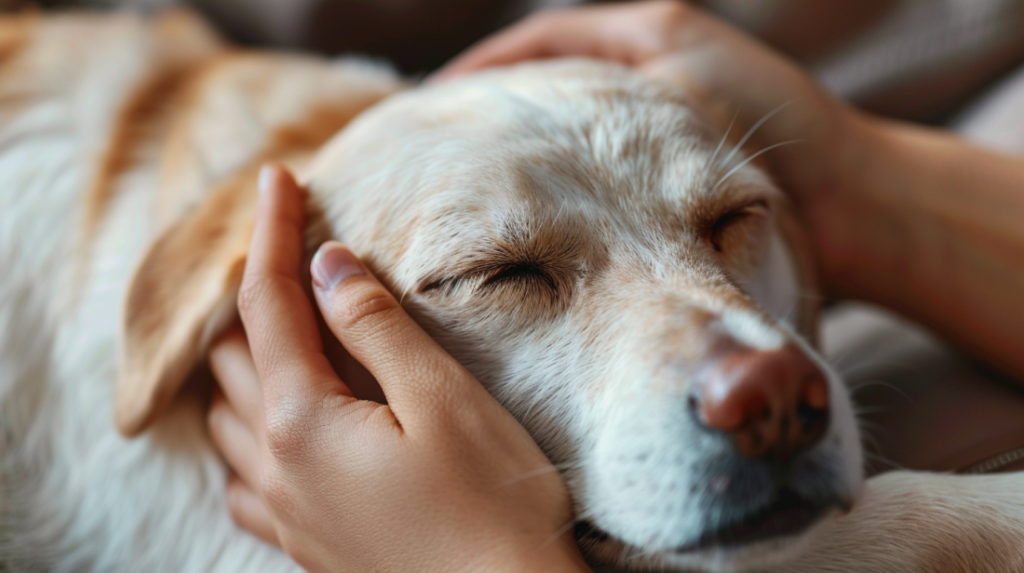
Pets experience stress and anxiety just like humans do. Whether it’s thunderstorms, fireworks, separation anxiety, or veterinary visits, our furry companions can become stressed for various reasons. As responsible pet parents, calming stressed pets should be a priority in our care routine. Not only does chronic stress impact your pet’s quality of life, but it can also lead to behavioral issues and health problems over time.
According to the American Veterinary Medical Association, nearly 20% of dogs and 25% of cats show signs of significant anxiety-related behaviors. These statistics highlight how common pet stress is—and why having effective calming strategies is essential for every pet owner.
This comprehensive guide explores gentle, proven methods for calming stressed pets quickly and effectively. We’ll cover non-invasive approaches that respect your pet’s natural behaviors while providing much-needed relief during stressful situations.
The Science Behind Pet Stress
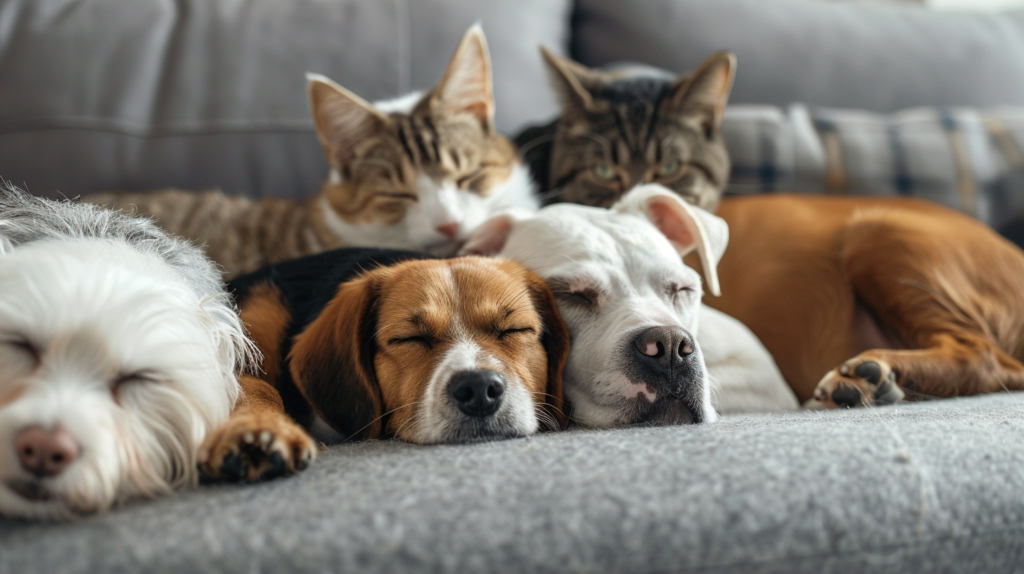
Before diving into calming techniques, it’s important to understand what happens in your pet’s body during stress.
The Physiological Stress Response
When pets become stressed, their bodies release cortisol and adrenaline—the same stress hormones humans produce. This triggers the “fight or flight” response, causing:
- Increased heart rate and blood pressure
- Rapid breathing
- Heightened alertness
- Digestive slowdown
- Muscle tension
Dr. Emma Stanley, veterinary behaviorist at the Animal Behavior Institute, explains: “The stress response is actually a normal, protective mechanism that prepares animals to respond to potential threats. The problem occurs when this response is triggered too frequently or for prolonged periods, leading to chronic stress.”
Common Stress Triggers in Pets
Understanding what stresses your pet is the first step toward helping them. Common triggers include:
| Stress Trigger | Dogs | Cats |
| Loud noises (thunder, fireworks) | Very common | Common |
| Separation from owners | Very common | Common in some cats |
| Changes in routine | Common | Very common |
| New environments | Common | Very common |
| Car travel | Common | Very common |
| Veterinary visits | Common | Very common |
| New people or animals | Varies by temperament | Common |
| Lack of exercise/stimulation | Common | Less common |
Research published in the Journal of Veterinary Behavior found that 73% of dogs exhibit anxiety-related behaviors during thunderstorms, while 60% of cats show stress responses when introduced to new environments.
Signs Your Pet Is Stressed

Recognizing stress signals is crucial for early intervention. Dogs and cats display stress differently, so let’s look at the specific signs for each.
Signs of Stress in Dogs
- Physical signs:
- Excessive panting or drooling
- Trembling or shaking
- Tucked tail
- Raised hackles
- Tense body posture
- Dilated pupils
- Excessive shedding
- Behavioral signs:
- Pacing and restlessness
- Excessive barking or whining
- Destructive behavior (chewing, digging)
- Hiding or escape attempts
- Reduced appetite
- Excessive licking or self-grooming
- Increased aggression
- House soiling despite being housetrained
Signs of Stress in Cats
- Physical signs:
- Dilated pupils
- Flattened ears
- Puffed-up tail
- Arched back
- Excessive grooming (may lead to bald spots)
- Changes in appetite
- Digestive issues
- Behavioral signs:
- Hiding more than usual
- Increased vocalization or unusual silence
- Inappropriate elimination (outside litter box)
- Decreased grooming or excessive grooming
- Aggression toward people or other pets
- Excessive scratching of furniture
- Changes in sleep patterns
- Increased startling
A 2023 study in the International Journal of Veterinary Science found that 67% of pet owners miss early signs of stress in their animals, often only recognizing the problem when it escalates to more severe symptoms. Being proactive in identifying these subtle cues can help you intervene before your pet’s stress worsens.
5 Gentle Ways to Calming Stressed Pets Fast

Now that we understand the fundamentals of pet stress, let’s explore five effective, gentle approaches to calming stressed pets quickly.
1. Create a Safe Haven: The Power of Secure Spaces
One of the most effective ways of calming stressed pets is providing them with a designated safe space where they can retreat when feeling anxious.
For Dogs:
- Crate training: When done properly, crates become positive, secure dens. Use comfortable bedding and cover part of the crate with a blanket to create a cave-like environment.
- Quiet room: Designate a low-traffic room where your dog can retreat. Include their bed, toys, and water.
- Under-furniture spaces: Some dogs naturally seek out spaces under tables or desks. Make these areas comfortable and accessible.
For Cats:
- Elevated spaces: Cats often feel safer when they can observe from above. Cat trees, shelves, or cleared bookcase tops work well.
- Hiding boxes: Simple cardboard boxes with entrance holes can provide instant security.
- Covered beds: Cat caves or covered beds offer privacy and security.
Expert tip: Dr. Lisa Thompson, feline behavior specialist, recommends: “Place safe spaces in multiple locations throughout your home so your cat always has a nearby retreat option. This is especially important in multi-pet households where a stressed cat might need to escape from other animals quickly.”
A 2022 study found that providing multiple hiding spots reduced stress-related behaviors in shelter cats by 47% compared to cats in environments with limited hiding options.
Making Safe Spaces Effective:
- Keep these areas stocked with comfort items (favorite toys, blankets with your scent)
- Never force your pet into their safe space or remove them from it
- Respect the space as a “do not disturb” zone
- Consider using pheromone diffusers nearby (more on this later)
- Maintain consistent access—don’t suddenly block or move these spaces
2. Touch Therapy: Massage and TTouch for Fast Calming
Physical touch, when applied correctly, can have remarkable calming effects on stressed pets. Two particularly effective methods are pet massage and the Tellington TTouch method.
Pet Massage Basics
Simple massage techniques can help reduce muscle tension and promote relaxation:
- Long strokes: Use gentle, slow strokes from head to tail to calm your pet (similar to petting but with slightly more pressure)
- Circular motions: Apply gentle circular pressure around shoulder blades and hips
- Ear massage: Gently rub the base of the ears where they meet the head
- Head and neck: Many pets particularly enjoy gentle massage at the base of the skull
The key is to use gentle, predictable pressure. Monitor your pet’s response—if they move away or seem uncomfortable, try a different area or technique.
Tellington TTouch Method
Developed by Linda Tellington-Jones, this specialized approach uses specific circular touches, lifts, and movement exercises to reduce stress:
- TTouch circles: Using your fingertips, gently move the skin in small (1-inch) clockwise circles
- Ear slides: Gently slide your fingers from the base of the ear to the tip
- Python lifts: Gently lift small sections of skin and hold briefly before releasing
Research published in the Journal of Applied Animal Welfare Science found that just 5 minutes of appropriate touch therapy reduced heart rates in anxious shelter dogs by an average of 22%.
Safety note: Before beginning any touch therapy, ensure your pet is comfortable. Never force physical contact with a highly agitated pet, as this could increase stress or risk injury.
3. Sound Solutions: Auditory Calming Techniques
Sound plays a surprisingly important role in calming stressed pets. The right auditory environment can significantly reduce anxiety.
Music Therapy
Not all music is created equal when it comes to calming stressed pets. Studies have shown that:
- Classical music, particularly pieces with 50-60 beats per minute, reduces anxiety behaviors in 70% of shelter dogs
- Reggae and soft rock have shown similar calming effects
- Species-specific calming music (designed for dogs or cats) can be even more effective
A groundbreaking study by the Scottish SPCA and University of Glasgow found that dogs listening to classical music spent significantly more time resting and less time standing or barking compared to when heavy metal or pop music was played.
Try playing calming music about 15-20 minutes before a stressful event (like before fireworks or thunderstorms) and maintain a consistent, moderate volume.
White Noise and Nature Sounds
For some pets, particularly those sensitive to environmental noises:
- White noise machines can mask startling sounds
- Nature sounds like gentle rainfall or forest ambiance can be soothing
- Air purifiers or fans provide consistent background noise that blocks out triggers
Product recommendation: The Pet Acoustics Pet Tunes Bluetooth Speaker preloaded with species-specific calming music has shown promising results for many BlithePet readers.
Audiobooks and Human Voices
The sound of calm human voices can be remarkably effective:
- Leave an audiobook playing when you’re away from home
- Record yourself speaking calmly and play it back during stressful times
- Use a consistent, gentle tone when speaking to anxious pets
4. Scent and Pheromone Therapy: Olfactory Calming
A pet’s sense of smell is significantly more powerful than ours, making scent an effective pathway for calming stressed pets.
Synthetic Pheromones
These products mimic natural calming pheromones that dogs and cats produce:
- For dogs: Products containing Dog Appeasing Pheromone (DAP) simulate the comforting pheromones mother dogs release when nursing puppies
- For cats: Feline facial pheromone products mimic the scent cats leave when they rub their faces on objects, signaling “safe territory”
These products come in various forms:
- Plug-in diffusers (best for continual use in specific rooms)
- Sprays (good for car travel or specific objects)
- Collars (provide ongoing, mobile calming)
- Wipes (useful for carriers or new objects)
A clinical study published in the Journal of the American Veterinary Medical Association found that DAP diffusers reduced anxiety-related behaviors in 74% of dogs with noise phobias.
Essential Oils
Some essential oils have calming properties, but extreme caution is needed as many are toxic to pets, especially cats.
Safe options for dogs (when properly diluted and used in diffusers only):
- Lavender (very mild dilution)
- Chamomile
Never use essential oils directly on pets, in high concentrations, or around cats without veterinary guidance.
Important safety note: Always consult your veterinarian before using any essential oils around pets. Keep all oils and diffusers where pets cannot access them directly.
Comfort Scents
Familiar scents can provide significant security:
- An unwashed t-shirt or blanket with your scent
- Items from home when traveling
- Consistent use of the same laundry detergent on pet bedding
Research shows that shelter dogs exposed to lavender aromatherapy showed decreased activity and increased resting behaviors compared to control groups, suggesting reduced stress levels.
5. Mind-Body Techniques: Calming Through Mental Engagement
Engaging your pet’s mind can be one of the most effective ways of calming stressed pets, as mental focus can override anxiety responses.
Calming Training Exercises
Specific training techniques can help redirect anxious energy:
- “Watch me” or focus training: Teach your pet to maintain eye contact on command
- Touch targeting: Train your pet to touch their nose to your palm
- “Go to place” command: Train your pet to go to their bed or mat on command
- Deep pressure training: Teach your dog to accept and enjoy gentle pressure (like a thundershirt effect)
These commands give your pet something familiar to focus on during stressful situations.
Calming Enrichment Activities
Mental stimulation can redirect focus away from stressors:
- Licking activities: Licking releases endorphins that promote relaxation. Try lick mats with frozen yogurt, peanut butter, or wet food
- Puzzle toys: Food-dispensing toys that require focus and problem-solving
- Snuffle mats: Encourage natural foraging behaviors
- Slow feeders: Extend mealtime and promote focus
A study in the Journal of Veterinary Behavior found that dogs who engaged with food puzzles for 15 minutes showed a 29% decrease in cortisol levels compared to baseline measurements.
Controlled Breathing Influence
While pets don’t consciously control their breathing like humans, you can influence their respiratory patterns:
- Sit close to your anxious pet and maintain slow, deep, audible breaths
- Many pets will naturally synchronize their breathing with a calm owner
- This technique works particularly well when combined with gentle contact
Dr. James Morton, veterinary behaviorist, explains: “Animals are incredibly sensitive to our emotional states. When we consciously slow our breathing, our pets often respond by calming their own respiratory rates. It’s a simple but powerful technique for co-regulation.”
Combining Approaches for Maximum Effect
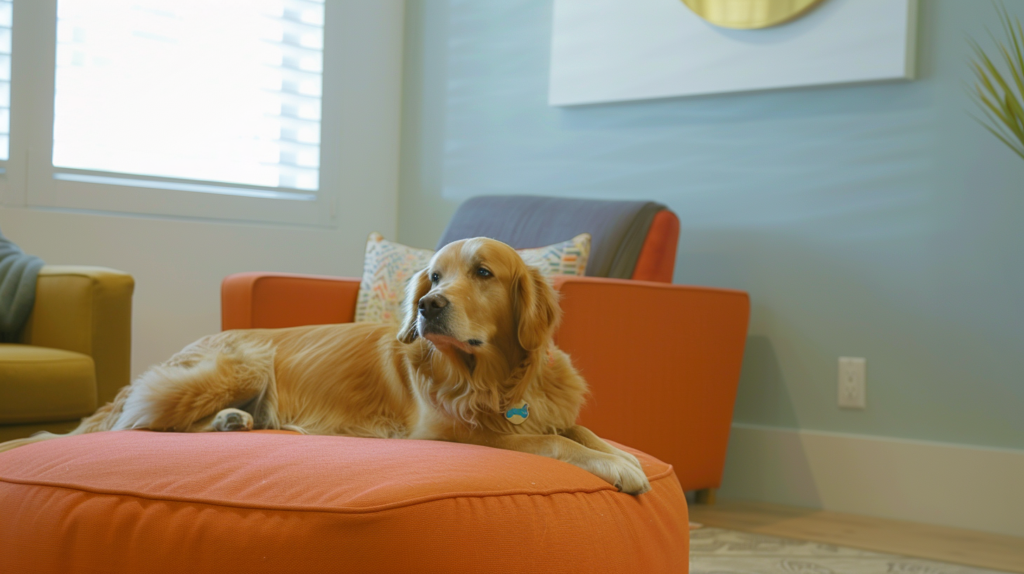
The most effective strategy for calming stressed pets often involves combining several of these gentle techniques. Here’s how to create a comprehensive calming protocol:
Sample Calming Protocol for Thunderstorm Anxiety
- Before the storm:
- Check weather forecasts to anticipate storms
- Set up your pet’s safe space with comfortable bedding
- Turn on calming music at a moderate volume
- Plug in appropriate pheromone diffusers 30-60 minutes before the storm
- Engage in 5-10 minutes of calm play or training
- During early signs of anxiety:
- Guide your pet to their safe space (don’t force them)
- Provide a licking mat or puzzle toy
- Use TTouch or gentle massage if welcomed
- Maintain calm, normal behavior (avoid reinforcing anxiety with excessive coddling)
- Use trained focus commands to redirect attention
- During peak anxiety:
- Respect hiding if chosen
- Maintain background music or white noise
- Use pressure wraps if your pet responds well to them
- Continue calm breathing near your pet
- Avoid punishment for anxiety behaviors
Creating Personalized Calming Plans
Every pet is unique in their triggers and responses. To create a personalized calming plan:
- Keep a stress journal:
- Document what triggers your pet
- Note which calming techniques seem most effective
- Track duration and intensity of anxiety episodes
- Record any patterns you notice (times of day, circumstances, etc.)
- Test techniques individually:
- Introduce one new calming method at a time
- Give each method multiple trials before deciding effectiveness
- Watch for subtle improvements (not just complete resolution)
- Consult professionals when needed:
- Your veterinarian can rule out medical causes for anxiety
- Certified animal behaviorists can provide customized training plans
- For severe cases, medication may be necessary alongside behavioral approaches
When to Seek Veterinary Help

While these gentle techniques are effective for mild to moderate stress, some situations require professional intervention.
Red Flags That Require Veterinary Attention
Seek help if your pet:
- Shows sudden onset of severe anxiety without obvious triggers
- Exhibits self-injurious behaviors (excessive licking, chewing on themselves)
- Has anxiety that significantly impairs normal functioning (refusing food, water, or elimination)
- Displays aggression linked to fear or anxiety
- Shows no improvement with home management techniques
- Has anxiety that worsens over time despite intervention
Professional Treatment Options
Your veterinarian may recommend:
- Comprehensive health assessment: To rule out medical causes of anxiety-like behaviors
- Prescription medications: Both short-term and long-term options exist
- Referral to veterinary behaviorist: For specialized treatment plans
- Formal behavior modification protocols: Professional-guided desensitization and counterconditioning
A 2023 survey found that 62% of pets with anxiety disorders showed significant improvement when professional behavioral guidance was combined with appropriate at-home calming techniques.
Natural Supplements for Calming Stressed Pets

Several over-the-counter supplements may help with mild anxiety. Always consult your veterinarian before starting any supplement regimen.
Common Calming Supplements
For dogs and cats:
- L-Theanine: An amino acid that promotes relaxation without sedation
- Magnolia and Phellodendron extracts: Traditional herbs with mild anxiety-reducing properties
- Alpha-casozepine: A milk protein with calming effects
- Tryptophan: An amino acid that helps produce serotonin
For dogs only:
- Zylkene: Contains casein, a milk protein with calming properties
- Composure Pro: Contains colostrum calming complex, L-Theanine, and thiamine
For cats only:
- Solliquin: Contains L-Theanine, magnolia extracts, and whey protein
A study in the Journal of Veterinary Behavior found that L-Theanine supplementation reduced anxiety scores by 35% in storm-phobic dogs compared to placebo groups.
Safety Notes on Supplements
- Start with the lowest recommended dose
- Allow 2-4 weeks to see full effects for most supplements
- Keep detailed notes on any changes (positive or negative)
- Never combine supplements without veterinary guidance
- Supplements are generally most effective for mild anxiety
Creating a Long-Term Stress Prevention Plan
While fast-acting techniques are essential for acute stress, preventing anxiety is always preferable. Here’s how to build resilience in your pet:
Daily Habits That Reduce Baseline Stress
- Consistent exercise: Physical activity naturally reduces stress hormones
- Dogs: 30-60 minutes daily, appropriate to breed and age
- Cats: 2-3 play sessions daily, 10-15 minutes each
- Predictable routines: Regular schedules for feeding, walking, and play reduce uncertainty-related stress
- Environmental enrichment: Regular introduction of appropriate new toys, textures, and experiences
- Socialization: Ongoing positive exposure to different people, animals, and environments (appropriate to your pet’s personality)
- Training maintenance: Regular practice of basic commands builds confidence
Desensitization for Common Stressors
For known triggers, gradual desensitization can build tolerance:
- Identify the trigger (thunder sounds, car rides, strangers)
- Create a very mild version of the trigger (very quiet recording, sitting in stationary car)
- Pair with positive experiences (treats, play, affection)
- Gradually increase intensity over weeks or months
- Never force exposure beyond your pet’s comfort level
A 2022 longitudinal study found that dogs who underwent structured desensitization to thunderstorm sounds showed 80% reduction in anxiety behaviors during actual storms after 12 weeks of training.
Products That Help With Calming Stressed Pets
Several products on the market can supplement the techniques discussed above:
Pressure Wraps and Anxiety Garments
- ThunderShirt: Applies gentle, constant pressure to the torso
- Anxiety Wrap: Similar concept with slightly different pressure points
- Calming Caps: Reduces visual stimulation for highly reactive dogs
Research shows these products reduce anxiety symptoms in approximately 80% of dogs, though effectiveness varies by individual.
Calming Beds and Furniture
- Donut beds: Raised edges provide security for curling animals
- Cave beds: Provide both soft comfort and hiding opportunities
- Weighted blankets designed for pets: Provide calming deep pressure
Tech Solutions
- RelaxoPet: Uses inaudible vibrations to calm pets
- Calming playlist apps: Specifically designed music for pets
- Smart feeders: Help maintain routine when you’re away
Frequently Asked Questions About Calming Stressed Pets
Q: Can I use human anxiety medications for my pet?
A: No. Human medications are dosed for humans and can be extremely dangerous or fatal to pets. Never give human medication without specific veterinary guidance.
Q: My pet only gets stressed during specific events (fireworks, travel). Should I still use daily calming techniques?
A: Yes. Building a foundation of calm behavior makes it easier for your pet to cope with occasional stressors. Think of it as emotional fitness training.
Q: How can I tell if my pet’s anxiety is improving?
A: Look for subtle changes like: reduced alertness during triggers, faster recovery after stressful events, willingness to eat treats during mild stress, and return to normal activities more quickly.
Q: Do calming techniques work differently for puppies/kittens versus senior pets?
A: Yes. Young animals may respond more quickly to training approaches, while senior pets might benefit more from environmental modifications and comfort-based approaches. Senior pets with cognitive changes may need additional support.
Q: Can anxiety be completely cured in pets?
A: Rather than “cured,” think of anxiety as “managed” or “improved.” With consistent work, many pets show dramatic improvements, but maintaining calming practices usually remains important throughout life.
Q: Is my anxious behavior affecting my pet’s stress levels?
A: Absolutely. Pets are extremely sensitive to our emotions. Practicing your own calm responses to situations can significantly impact your pet’s emotional state.
For More Expert Pet Care Tips
For more expert pet care tips and product recommendations, visit BlithePet.com — your trusted source for pet wellness.
Conclusion: Compassionate Care for Calming Stressed Pets
Understanding and calming stressed pets requires patience, consistency, and a multi-faceted approach. By recognizing your pet’s unique stress signals and implementing the gentle techniques discussed in this guide, you can help your furry companion navigate anxiety-provoking situations with greater ease.
Remember that improvement often comes gradually—celebrate small victories and continue refining your approach based on your pet’s individual responses. With time and dedication, most pets can experience significant reductions in anxiety and enjoy a more relaxed, confident life.
Have a similar experience with your pet? Share it in the comments below!



